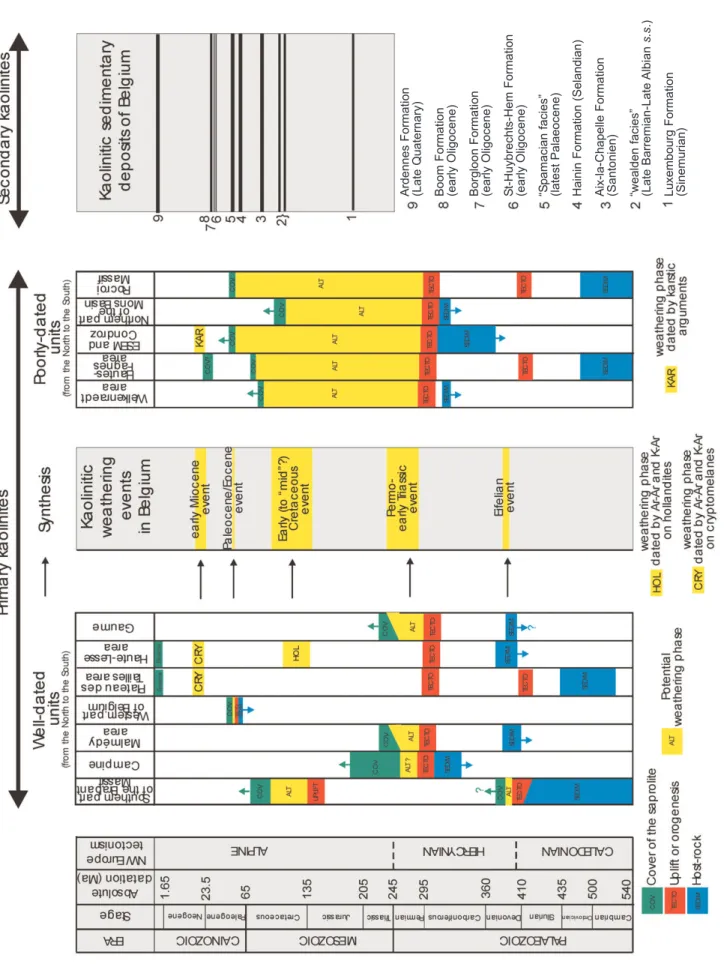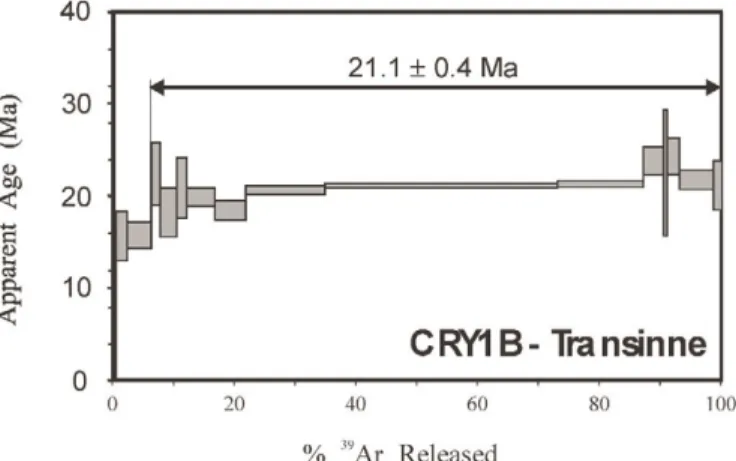Introduction
This paper aims to get an overview of the kaolinitic weathering events (= primary kaolinite) that affect the Belgian rocks over geological times. The kaolinite formed in these events can be later eroded, transported and deposited within younger sediments (= secondary kaolinite). We focus here on the dating of the primary kaolinite neoformations and on the dating of the potential inherited secondary kaolinitic sediments from Belgium.
Special attention is given to the following question: could the extensive stock of neoformed kaolinite in the Ardenne area supply the kaolinitic Wealden facies of the Mons Basin? We therefore present new results on 1) geochronological dating of some weathering profiles from the Ardenne and 2) precise palynological dating of the Wealden facies of the Mons Basin.
This approach contributes to improve palaeogeographic reconstructions. Later it might also help deciphering major lithospheric deformations in Belgium during the Mesozoic and Cainozoic times by studying the vertical movements of the weathering profiles versus different “plane surfaces” elevations.
Overview of the saprolites of Belgium
(
≈≈ primary kaolinite)
We suggest to group the numerous saprolites into “geological and/or geographical units”. Each so-called unit includes saprolites which are 1) covered by the same
discordant sediments (when present) and 2) homogeneous by the geological (i.e. Brabant Massif or Stavelot Massif) and/or geographical (i.e. Haute-Lesse area, Welkenraedt area) points of view. The weathering dating is mainly based on “stratigraphic” arguments. The weathering phase(s) is (are) indeed:
- younger than the age of the host-rocks and younger than the last (pre-weathering) tectonic event (major thrust faulting, uplift) that affected the host-rocks,
- older than the age of the overlying discordant cover. From the North to the South of Belgium, we can distinguish 12 main units summarized in the Table 1 and roughly located on the Figure 1. The Figure 2 shows the stratigraphy of the host-rock, the last (pre-weathering) tectonic event and the sealing sediments of all these units. The weathering age of five of the units (Southern part of the Brabant Massif, Campine, Malmédy area, Western part of Belgium and Gaume) can be deduced from the “stratigraphic” arguments. The ages of the weathering on the Haute-Lesse and the Plateau des Tailles areas are discussed below. On this basis, at least four Mesozoic and Cainozoic main kaolinitic weathering events can be highlighted at the Permian-Early Triassic, Early (to “mid”?) Cretacecous, Palaeocene-Eocene interval and the Early Miocene. These events do correlate with the major weathering phases deciphered in the whole Northwestern Europe (Quesnel et al., 2002 a,b). The weathering age of the other areas remain too poorly constrained.
of Belgium
and their potential kaolinitic
supplies to Mesozoic
and Cainozoic sediments
Johan YANS
with the collaboration of:
A. CHAUVIN (2), N. CLAUER (3), J. DEJAX (4),
Th. DE PUTTER (1), Ch DUPUIS (1),
G. FERAUD (5), F. GUILLOCHEAU (6),
E. MASURE (7), I. LEOST (5), A. PERRUCHOT (8),
D. PONS (7), P. SPAGNA(1), R. WYNS(9)
(1) Faculté Polytechnique de Mons (FPMs), Géologie fondamentale et appliquée, 9, rue de Houdain, 7000 Mons, Belgium. johan.yans@fpms.ac.be (2) Geosciences-Rennes, (3) Université de Strasbourg, (4) Museum d’Histoire Naturelle de Paris, (5) Université de Nice, (6) Geosciences-Rennes, (7) Université de Paris VI, (8) Université de Paris-Sud Orsay, (9) BRGM, CDG/MA, Orléans.
Géologie de la France, 2003, n° 1, 33-37, 1 tabl., 3 fig.
Key words: Paleoweathering, Mesozoic, Tertiary, Kaolinite, Dating, K/Ar, 40Ar/39Ar, Manganese oxides, Hollandite, Cryptomelane,
Table 1.- Ages of the host-rock, last (pre-weathering) tectonic event and the discordant sedimentary cover of each weathered unit in Belgium.
Fig. 2.- T
entative synthesis of the kaolinitic paleoweathering events in Belgium and stratigraphy of the potential inherited ka
olinitic deposits.
Ardennes Formation (Late Quaternary) Boom Formation (early Oligocene) Borgloon Formation (early Oligocene) St-Huybrecht
s-Hem Formation
(early Oligocene) “Spamacian facies” (latest Palaeocene) Hainin Formation (Selandian) Aix-la-Chapelle Formation (Santonien) “wealden facies” (Late Barremian-Late
Albian
s.s
.)
Overview of the kaolinitic deposits of
Belgium (
≈≈ secondary kaolinite)
The stratigraphy of the main potentially inherited kaolinitic deposits of Belgium is mentioned in the Figure 2. These sediments can inherit kaolinite only from areas where this latter has already neoformed : for example the kaolinite from the Sinemurian Luxembourg Formation can not be inherited from the Early (to mid?) Cretaceous weathering event…
Dating a case-study weathering profile
(Ardenne area) and a potential secondary
kaolinitic deposit (Wealden facies of the
Mons Basin)
We show here that both the precise dating of the weathering that affected an area and the precise dating of kaolinitic deposits in another area may be powerful tools to improve paleogeographical investigations. We can therefore focus on a case-study hypothesis (Dupuis, 1992 and Dupuis et al., 1997) : the kaolinite of the Wealden facies of the Mons Basin may have been inherited from the weathered profiles of the Ardenne area.
Dating the weathering profiles of the Ardenne area
The Haute-Lesse area (Westen part of the Ardenne area) is strongly affected by weathering that results in deep (>60 meters in a borehole at Transinne) profiles (Dupuis et al., 1997). The precise age(s) of the weathering is unknown (Demoulin, this volume) due to 1) the absence of pre-Quaternary cover and 2) the difficulties to find suitable material for dating.Recently new geochronological dating methods of the weathering (Gilg, this volume) developed on hollandite (BaMn8O16) - cryptomelane (KMn8O16) minerals (Vasconcelos et al., 1992) which:
- are quite rich in potassium (K) and allow to use the K-Ar and K-Ar-K-Ar methods,
- crystallized within oxidizing conditions (≈ supergene origin) in genetic relations with kaolinite neoformations,
- are quite common in the weathering profiles,
- do preserve K and Ar after crystallisation due to specific mineralogical properties.
In the Transinne profile we studied two kinds of manganese oxides:
- hollandites from the upper part (15 to 20 m deep) of the profile, by using K-Ar method on mineral powder,
- cryptomelanes from the basal part of the profile, by using Ar-Ar step-heating on single grain and K-Ar methods on mineral powder.
The K-Ar apparent ages of the hollandites range from 126 ± 10 and 131 ± 15 Ma (from Berriasian to Barremian). Moreover paleomagnetic data from the upper part of the profile do support a Mesozoic weathering phase. Note that some other weathering parageneses are thought to be Cretaceous in age:
- the widespread weathering of the Southern part of the Brabant Massif (Dupuis, 1992),
- the lateritic profile of the “Borne de Fer” located in the Northeastern France (Quesnel et al., 2002a,b ; Théveniaut et al., 2002),
- the Thermae profile in the Limburg - The Netherlands (Thorez, 1987; Batten et al., 1987).
On the other hand both Ar-Ar (Fig. 3) and K-Ar results suggest that the cryptomelanes of the basal part of the profile are Early Miocene in age (21.1 ± 0.4 Ma). Note that some other weathering parageneses are also Early Miocene in age:
- cryptomelanes collected at the base of the weathering profiles in the Plateau des Tailles area – Eastern part of the Ardenne area (unpubl. data),
- some manganese oxides collected in the Eastern part of the Rhenish Massif - Germany (Hautmann and Lippolt, 2000),
- kaolinites and surrounding monazites in the Entre-Sambre-Et-Meuse area (De Putter et al., 2002; Dupuis et al., this volume),
- meteoric phase (“septarias” neoformation) in the Oligocene Boom Clay Formation (Vandenberghe and Laga, 1986),
Fig. 3.- 40Ar-39Ar spectra of the cryptomelane of the basal part of the
- weathering profiles in the Massif Central (France), Vogelsberg and Fichtelgebirge (Germany), Sudetes (Czech Republic and Poland) - see references in Migon and Lidmar-Bergström (2001 and 2002).
Hence the kaolinitic profiles of the Haute-Lesse area are the result of two paleoweathering phases (“polyphased paleoweatherings”). The Early Cretaceous and the Early Miocene periods seem to offer the favourable conditions (climatic, eustatic and/or tectonic causes ?) allowing for deep weathering process in the Central and Northwestern Europe.
Dating the kaolinitic deposits: the Wealden facies
of the Mons Basin
A recent synthesis suggests that the Wealden facies of the Mons Basin are roughly dated from Late Jurassic to Early Cretaceous (Robaszynski et al., 2001). On the basis of the 1) angiospermian pollen and 2) dinoflagellate contents,
new palynological studies demonstrate that the Wealden facies of the Western part of the Mons Basin (Bernissart sinkhole and Hautrage “pocket”) are Late Barremian and that the Wealden facies of the Eastern part of the Mons Basin are Late Albian sensu stricto (Yans et al., 2002).
Integration of the results
The kaolinite deposition age of the Wealden facies in the Mons Basin (Late Barremian to Late Albian sensu stricto) is consistent with the late period (Early Cretaceous) of the kaolinite formation in the Ardenne area. On this basis we may conclude that a kaolinitic supply from the weathered profiles of the Ardenne area to the Wealden facies of the Mons Basin is possible. The potential paleogeographic links between the Ardenne and the Mons areas should be precised by comparing the mineralogical characteristics of the kaolinites from the both areas…
Bibliographic orientation
Batten D. J., Streel M., Dusar M., Bless M.J.M. (1987) - Late Cretaceous palynomorphs from the boreholes Thermae 2002 (Valkenburg a/d Geul, The Netherlands) and s’Gravenvoeren (Belgium). Ann. Soc. géol. Belgique, 110, 47-51.
Demoulin A. (2003) - Paleosurfaces and residual deposits in Ardenne-Eifel: historical overview and perspectives. This Volume, 5 p.
De Putter T., André L., Bernard A., Dupuis C., Jedwab J., Nicaise D., Perruchot A. (2002) - Trace element (Th, U, Pb, REE) behaviour in a cryptokarstic halloysite and kaolinite deposit from Southern Belgium : importance of « accessory » mineral formation for radioactive pollutant trapping. Applied geochemistry, 17, 1313-1328.
Dupuis C. (1992) - Mesozoic kaolinised giant regoliths and Neogene halloysite cryptokarsts : two stricking paleoweathering types in Belgium in Schmidt and Gall eds (Mineralogical and geochemical records of paleoweathering), ENSMP, 18, 61-68.
Dupuis C., Charlet J.-M., Dejonghe L., Thorez J. (1997). Reconnaissance par carottage des paléoaltérations kaolinisées mésozoïques de la Haute-Ardenne (Belgique). Le sondage de Transinne (194E-495) : premiers résultats. Ann. Soc. Géol. Belgique, 119, 91-109.
Hautmann S., Lippolt H.J. (2000) - 40Ar-39Ar dating of central European K-Mn oxides – a chronological framework of supergene alteration processes during the Neogene. Chemical Geology, 170, 37-80.
Migon P., Lidmar-Bergtröm K. (2001) - Weathering mantles and their significance for geomorphological evolution of central and northern Europe since the Mesozoic. Earth-Science Reviews, 56, 285-324.
Migon P., Lidmar-Bergtröm K. (2002) - Deep weathering through time in central and northwestern Europe: problems of dating and interpretation of geological record. Catena, 49, 25-40.
Quesnel F., Giot D., Robelin C., Roger J., Wyns R., Casanova J. (2002a). Apports des paléoaltérations et des paléosurfaces à la reconstitution de l’histoire hydrogéologique de l’est de la France (projet SEDIMOR), Journée du Partenariat de Recherche et Développement entre le BRGM et l’ANDRA, Orléans, France, 5 mars 2002, Programmes et résumés, 57-62.
Quesnel F., Dupuis C., Yans J., Wyns R., Farjanel G., Théveniaut H., Voisin L., Lacquement F., Vergari A., Baele J.-M., Deputter T., Colbach R., Muller A., Vandycke S., Giot D. & Brulhet J. (2002b). Paléosurfaces et paléoaltérations dans le Nord de la France et en Belgique. Géologues, 133-134, 40-43. Robaszynski F., Dhondt A., Jagt J.W.M.(2001) - Cretaceous lithostratigraphic units (Belgium). Geologica belgica, 4, 1, 121-134.
Théveniaut H., Wyns R., Quesnel F. (2002) – Etude paléomagnétique de la borne de fer. Journée du Partenariat de Recherche et Développement entre le BRGM et l’ANDRA, Orléans, France, 5 mars 2002, Programme et résumés, 63-65.
Thorez J. (1987) - Clay mineralogy of some clayey intervals in the Thermae 2002 borehole (Valkenburg a/d Geul, The Nederlands). Ann. Soc. géol. Belgique, 110, 53-58.
Vandenberghe N., Laga P. (1986) - The septarias of the Boom Clay (Rupelia n) in its type area in Belgium. Aardkundige Mededelingen, 3, 229-238. Vasconcelos P.M, Becker T.A., Renne P.R., Brimhall G.H. (1992) - Age and duration of weathering by 40K-40Ar and 40Ar/39Ar analysis of potassium-manganese oxides. Science, 258, 451-455.
Yans J., Spagna P., Foucher J.-C., Perruchot A., Streel M., Beaunier P., Robaszynski F., Dupuis C. (2002) - Multidisciplinary study of the Wealden deposits of the Mons Basin (Belgium) : a progress report. Aardkundige Mededelingen, 12, 39-42.


